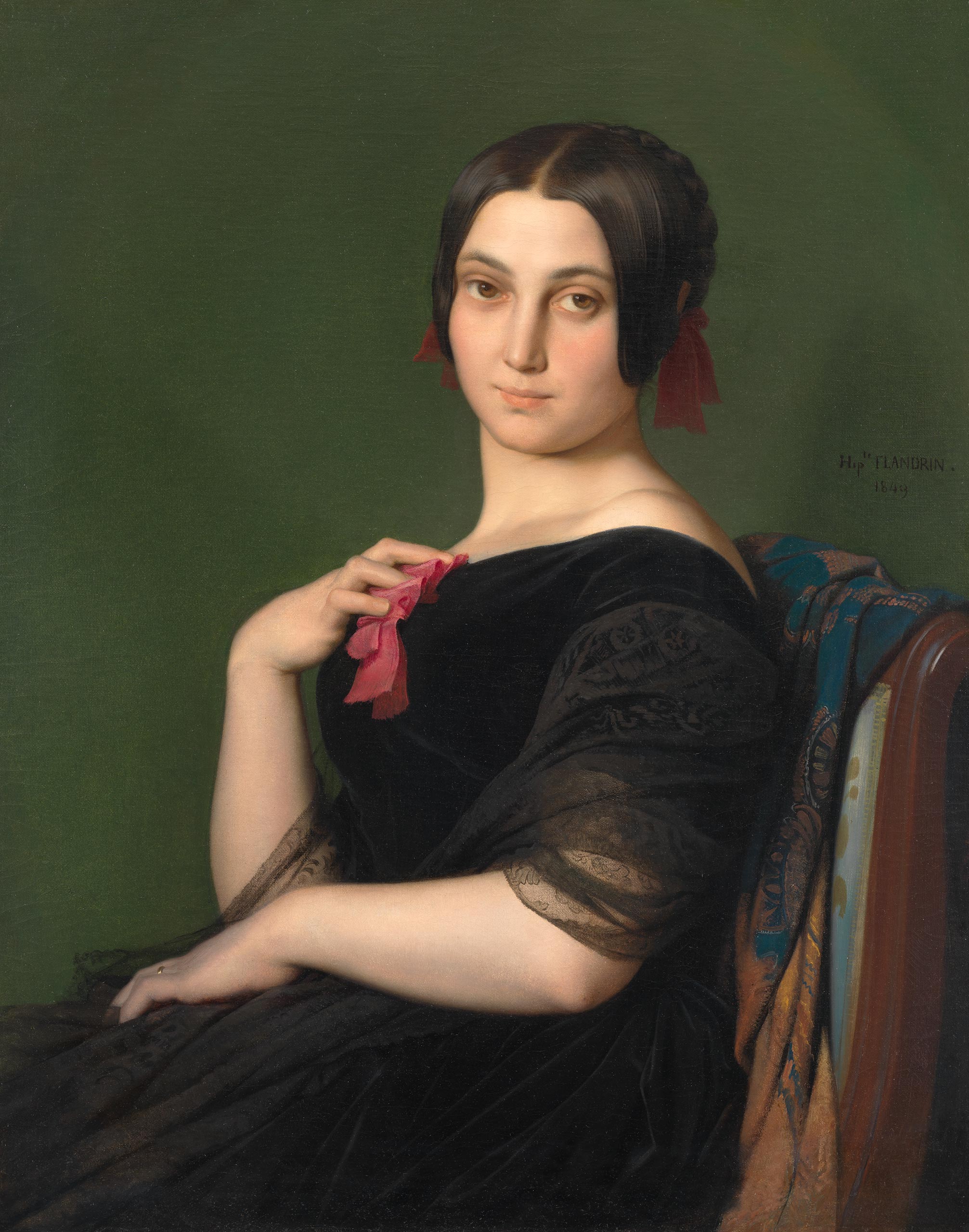
Flandrin
Hippolyte
Lyon 1809 — Rome 1864
Portrait of Pauline Ferrez (1825-1900),
Madame de Saint-Didier
Oil on canvas.
Signed and dated Hipte Flandrin 1849 center right.
81,8 x 65,5 cm (32 3/16 x 25 13/16 in.)
Madame de Saint-Didier, née Pauline Ferrez (1825 – 1900); her son, Ferdinand, baron de Saint-Didier (1847 – 1930); by descent to this day.
Henri Delaborde (contributeur), Lettres et pensées d’Hippolyte Flandrin : accompagnées de notes et précédées d’une notice biographique et d’un catalogue des œuvres du maître, Paris, Plon, p. 99 ; Louis Flandrin, Un peintre chrétien du XIXe siècle : Hippolyte Flandrin, Paris, Perrin, 1909, p. 350 ; Hippolyte, Auguste et Paul Flandrin, une fraternité picturale au XIXe siècle, exh. cat., Paris, RMN, 1984, p. 222.
Begun on May 16, 1849, this portrait is one of the finest representations of women by Lyon painter Hippolyte Flandrin, Ingres’ favorite pupil and a talented portraitist. Born into a sibling family characterized by a deep and touching mutual attachment, Hippolyte and his younger brother Paul left for Paris in 1829 and entered Ingres’ studio. Their eldest brother Auguste, a former pupil of Fleury-Richard who remained in Lyon to support the family, joined them a little later. Hippolyte won the Prix de Rome in 1832 and spent six years there, studying the great masters and history painting. Paul joined him at his own expense and specialized in landscape painting. A double self-portrait preserved in the Louvre, drawn jointly by the two brothers in Rome in 1835, immortalizes this close relationship. Auguste followed them in Rome in early May 1838. His death in 1842, shortly after their return to Paris, plunged Hippolyte and Paul into great sadness. Hippolyte devoted himself almost exclusively to religious painting, and received numerous commissions for church decorations. Those for the church of Saint-Germain-des-prés (1846-1848) are among the most spectacular, and would earn him many other commissions.
In excellent condition, on its original canvas, this portrait of Madame de Saint-Didier is one of the finest examples of the art of portraiture as the artist inherited it from his master Ingres and developed it in his own way, with psychological finesse and smooth, extremely meticulous workmanship. We would like to thank Elena Marchetti for kindly bringing to our attention two letters from Hippolyte who, after a stay in Nîmes, where he created decorations for Saint-Paul, spent a few weeks in Lyon, witnessing the popular uprising of June, before returning to Paris. On May 15, he wrote to Paul, “We’re staying here until the new assembly is installed, and maybe to make the most of my time, I’m going to paint the portrait of Mme de St Didier, daughter of Mr. Ferez, which I’m really afraid of”. On May 17, he wrote: “Yesterday I began the portrait of Mme de Saint- Didier. It could be very beautiful, but I’d need a little more than the summer. Anyway, I’ll do my best.”
The artist’s intuition proved to be right; the portrait is indeed very beautiful, perhaps even one of the most intriguing, not only for its impeccable technique, but also for its ability to convey the hauting presence of the sitter. Pauline Ferrez (1825- 1900), daughter of a doctor from Lyon, had married Ennemond Hubert de Saint-Didier (1814-1898), from an old Lyon aristocratic family. Son of Balthazar Augustin Hubert de Saint-Didier (1779- 1863), author of several views and sites in the Lyon area and of a Voyage pittoresque du Bugey (1837), Ennemond is mentioned as a hospice administrator in 1844.
In this work, we find Flandrin’s characteristic attention to the model’s hands, which gives the work its internal dynamic. In Portrait de Madame Flandrin, painted in 1846 and now in the Louvre, the painter’s wife rests her left hand on her cheek, her right arm resting on her stomach and encircling her waist. The pose and gaze are pensive, chaste and introspective. As in our work, the background is green and the detail of an Indian shawl adds a refined touch of color to the scene. In our portrait, however, the model’s hands are more provocative. One is placed on the chest, in an almost mannered tautness that gives the painter the opportunity to demonstrate his talent for drawing and modeling this sometimes trying anatomical part, while the other is placed on the upper thighs. The curves of these arms and hands are extremely sensual, which is rare in this painter who, above all, reveals only his chaste, restrained temperament. They are also very different from those of Madame Louis Antoine de Cambourg’s, for example, which stretch out calmly as she stares at the viewer with wide, questioning eyes. Madame de Saint-Didier appears as a more voluptuous woman, and it is possible that the artist found in her a more southern temperament, similar to that of the women he painted during his Italian sojourn, notably the sensual Florentine (1840).
To further emphasize this voluptuous side, the artist chose to enclose the image in an almost oval format, with the corners cut off, leaving the four corners roughly painted, but still sufficiently so that the painting could later be placed in a rectangular frame, the one later chosen by the family and which is still retained today. The choice of format made sense to Ingres and his followers. We need only to recall the Rivière family triptych painted by Ingres in 1805, and the choice of different formats according to whether Ingres was painting the solid father, the curving mother or the innocent young girl. The choice of the oval for a very feminine woman, already the mother of two children, Béatrice and Ferdinand, is perhaps not insignificant.
Pauline Ferrez is also said to have been portrayed by Louis Janmot in 1851 in a beautiful drawing in the Tomaselli collection, in Lyon (Fig. 1)1. Curiously, while we recognize her large almond-shaped eyes and small, shaped mouth, she appears much younger in this drawing than in Flandrin’s portrait, painted two years earlier. Gracile, almost fragile, with a small chest, she looks very young, almost still a girl, far removed from the curvaceous woman painted by Flandrin, a totally different version of femininity.
-
Graphite pencil on wove paper, 430 x 290 mm. Signed and dated 1851, partially inscribed Place d’Ainay / Mr St Did on the verso.

